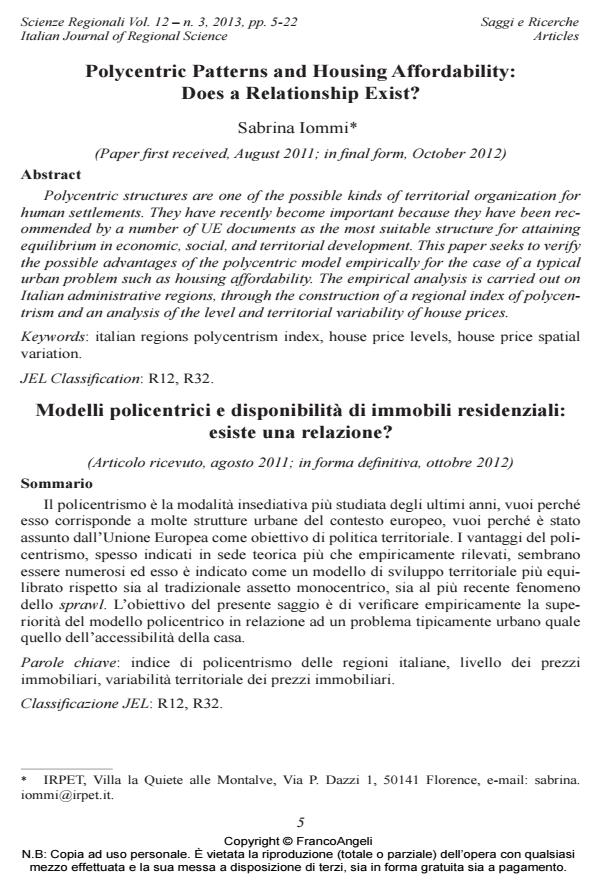Polycentric Patterns and Housing Affordability: Does a Relationship Exist?
Journal title SCIENZE REGIONALI
Author/s Sabrina Iommi
Publishing Year 2013 Issue 2013/3 Language English
Pages 18 P. 5-22 File size 477 KB
DOI 10.3280/SCRE2013-003001
DOI is like a bar code for intellectual property: to have more infomation
click here
Below, you can see the article first page
If you want to buy this article in PDF format, you can do it, following the instructions to buy download credits

FrancoAngeli is member of Publishers International Linking Association, Inc (PILA), a not-for-profit association which run the CrossRef service enabling links to and from online scholarly content.
Polycentric structures are one of the possible kinds of territorial organization for human settlements. They have recently become important because they have been recommended by a number of UE documents as the most suitable structure for attaining equilibrium in economic, social, and territorial development. This paper seeks to verify the possible advantages of the polycentric model empirically for the case of a typical urban problem such as housing affordability. The empirical analysis is carried out on Italian administrative regions, through the construction of a regional index of polycentrism and an analysis of the level and territorial variability of house prices.
Keywords: Italian regions polycentrism index, house price levels, house price spatial variation.
Jel codes: R12, R32.
- Alonso W. (1964), Location and Land Use: Toward a General Theory of Land Rent. Cambridge, MA: Harvard University Press.
- Alonso W. (1973), Urban Zero Population Growth. Daedalus, 102, 4: 191-206.
- Bagnasco A. (1977), Tre Italie: la problematica territoriale dello sviluppo italiano. Bologna: il Mulino.
- Banca d’Italia (2010), I bilanci delle famiglie italiane nell’anno 2008. Roma: Banca d’Italia, Supplementi al Bollettino Statistico, Indagini campionarie, Anno XX, 8.
- Camagni R. (1993), From City Hierarchy to City Network: Reflections about an Emerging Paradigm. In: Lakshmanan T. R., Nijkamp P. (eds.), Structure and Change in the Space Economy, Festschrift in Honour of Martin Beckmann. Berlin: Springer-Verlag. 66-87.
- Camagni R., Capello R. (2000), Beyond Optimal City Size: an Evaluation of Alternative Urban Growth Patterns. Urban Studies, 37, 9: 1479-1496.
- Camagni R., Salone C. (1993), Network Urban Structures in Northern Italy: Elements for a Theoretical Framework. Urban Studies, 30, 6: 1053-1064. DOI: 10.1080/00420989320080941
- Capello R. (2000), The City Network Paradigm: Measuring Urban Network Externalities. Urban Studies, 37, 11: 1925-1945. DOI: 10.1080/713707232
- D’Alessio G., Gambacorta R. (2007), L’accesso all’abitazione di residenza in Italia. Roma: Banca d’Italia, Questioni di Economia e finanza, Occasional Papers n. 9.
- Davoudi S. (2002), Polycentricity: What Does it Mean and how Is it Interpreted in the ESDP?. Paper presented at the EURA Conference Urban and Spatial European Policies: Levels of Territorial Government, held at Turin, April. DOI: 10.1080/0965431032000146169
- Davoudi S. (2003), Polycentricity in European Spatial Planning: From an Analytical Tool to a Normative Agenda. European Planning Studies, 11, 8: 979-999.
- European Union (1999), ESDP European Spatial Development Perspective. Towards Balanced and Sustainable Development of the Territory of the EU. http://ec.europa.eu.
- European Union (2007), Territorial Agenda of the EU. http://www.bmvbs.de/territorial-agenda.
- European Union (2008), Green Paper on Territorial Cohesion. Turning Territorial Diversity into Strength. http://ec.europa.eu.
- Gibb K. (2002), Trends and Change in Social Housing Finance and Provision within the European Union. Housing Studies, 17, 2: 325-336. DOI: 10.1080/02673030220123252
- Graziani A. (2005), Disagio abitativo e nuove povertà, Firenze: Alinea.
- Iommi S. (2008), La questione della casa in Toscana. Condizioni abitative, area del disagio e politiche pubbliche. (www.irpet.it).
- Iommi S. (2009), I prezzi degli immobili: determinanti, effetti e fonti statistiche. Materiali di lavoro per Toscana 2030. Mimeo.
- ISTAT (2009), Reddito e condizioni di vita. Anni 2006-2007. www.istat.it.
- ISTAT (2010), I consumi delle famiglie. Anno 2008. www.istat.it.
- Italian Ministry of Infrastructure and Federcasa (2006), Housing Statistics in the EU 2005-2006. www.federcasa.it.
- Meijers E. J. (2007), Synergy in Polycentric Urban Regions. Complementarity, Organising Capacity and Critical Mass. Amsterdam: Delft University Press.
- Meijers E. J. (2008), Measuring Polycentricity and its Promises. European Planning Studies, 16, 9: 1313-1323. DOI: 10.1080/09654310802401805
- Meijers E. J., Sandberg K. (2008), Reducing Regional Disparities by Means of Polycentric Development: Panacea or Placebo?. Scienze Regionali, 7, 2: 71-96.
- Nordregio (2004), ESPON 1.1.1 Potentials for Polycentric Development in Europe, Final Project Report. www.espon.eu.
- Park R. E., Burgess E., McKenzie R. (1967), The City. Chicago: University Press.
- Parr J. B. (2004), The Polycentric Urban Region: A Closer Inspection. Regional Studies, 38, 3: 231-240. DOI: 10.1080/003434042000211114
- Poggio T. (2009), Le principali dimensioni della disuguaglianza abitativa. In: Brandolini A., Saraceno C., Schizzerotto A. (eds.), Dimensioni della disuguaglianza in Italia: povertà, abitazione, salute. Bologna: il Mulino. 273-292.
- Priemus H., Dieleman F. (2002), Social Housing Policy in the European Union: Past, Present and Perspectives. Urban Studies, 39, 2: 191-200. DOI: 10.1080/00420980120102911
- Tosi A. (1994), Abitanti: le nuove strategie dell’azione abitativa. Bologna: il Mulino.
- Turola G. (2008), Manuale di estimo immobiliare. Milano: Il Sole 24 Ore.
- Whitehead Ch. (2003), The Economics of Social Housing. In: Gibb K., O’Sullivan T. (eds.), Housing Economics and Public Policy. London: Blackwell Publishing. 135-152.
- Dimensione e offerta funzionale nella crescita urbana. Alcune evidenze nel periodo 2001-2011 Davide Burgalassi, Sabrina Iommi, Donatella Marinari, in SCIENZE REGIONALI 2/2016 pp.37
DOI: 10.3280/SCRE2016-002003
Sabrina Iommi, Polycentric Patterns and Housing Affordability: Does a Relationship Exist? in "SCIENZE REGIONALI " 3/2013, pp 5-22, DOI: 10.3280/SCRE2013-003001